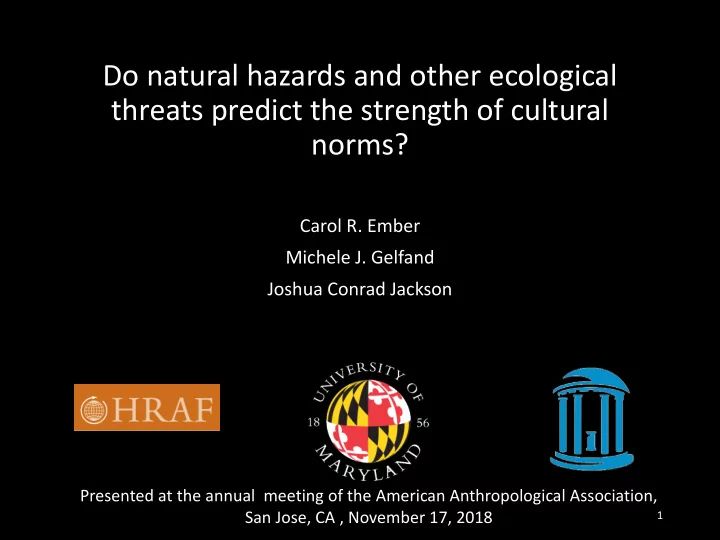

Do natural hazards and other ecological threats predict the strength of cultural norms? Carol R. Ember Michele J. Gelfand Joshua Conrad Jackson Presented at the annual meeting of the American Anthropological Association, San Jose, CA , November 17, 2018 1
Strength of Cultural Norms • For shorthand, we use the phrase “tight” vs. “loose” cultures • “Tight” refers to the degree to which social norms are pervasive, clearly defined, and reliably imposed (Gelfand et al. 2011) 2
10 12 14 0 2 4 6 8 Ukraine Estonia Hungary Israel Strength of Norms Across 33 Countries Netherlands Brazil Venezuela Greece New Zealand Australia USA Spain Belgium Poland France Hong Kong Iceland W Germany Austria Italy United Kingdom Mexico E Germany Portugal China Japan Turkey Norway S Korea Singapore 3 India Malaysia Pakistan
What may account for the variation? • A country’s greater experience with ecological threats (such as natural hazards) is a predictor of “tightness” (Gelfand et al. 2011) • U.S. states with more natural hazards are also “tighter” (Harrington and Gelfand 2014) 4
Food Deprivation Pathogen Prevalence 14 14 12 12 10 10 8 8 6 6 4 4 2 2 0 0 0 0.5 1 1.5 2 2.5 0 100 200 300 Population Density Territorial Threat Disasters 14 14 14 12 12 12 10 10 10 8 8 8 6 6 6 4 4 4 2 2 2 0 0 0 0 0.5 1 1.5 2 0 1 2 3 4 0 5 10 15 Gelfand et al ., 2011. The difference between tight and loose cultures. Science 5
Does this relationship hold in the ethnographic record? 6
Research Design Standard Cross-Cultural Sample (SCCS) • We coded strength of norms in 6 domains (wherever possible using eHRAF World Cultures) • Coded 86 societies in random order from the SCCS that were previously reliably measured on resource problems (about ½ the sample) 7
Measuring Strength of Norms in the Ethnographic Record For each of the following domains of life: Law and Ethics Gender Socialization Marriage Sexuality Funerals and Mourning We asked coders to assess: The degree to which norms constrained behavior The extent norms were followed Expected degree of punishment Harshness of punishment An overall assessment of tightness 8
Strength of Norms Across Domains 3.6 3.4 1. 2. 3. 4. 5. 6. 3.2 1. Law - Strength of Nor ms 3 2. Socialization .70** - 2.8 3. Gender .62** .47** - 2.6 4. Marriage .62** .56** .50** - 2.4 5. Sexuality .56** .49** .46** .43** - 2.2 6. Funerals .49** .51** .32* .46** .33* - 2 Law and Ethics Socialization Gender Marriage Sexuality Funerals and Mourning 9
Tightest and Loosest Societies Tightest Loosest 1. Aranda (3.77) 1. Mbuti (1.50) 2. Mbau Fijians (3.75) 2. Tehuelche (1.54) 3. Irish (3.75) 3. Siamese (2.02) 4. Japanese (3.71) 4. Javanese (2.04) 5. Koreans (3.67) 5. Huron (2.08) 6. Manus (3.63) 6. Warrau (2.08) 7. Ganda (3.60) 7. Havasupai (2.27) 8. Bambara (3.38) 8. Burmese (2.29) 9. Mapuche (3.33) 9. Orokaiva (2.42) 10.Amhara (3.33) 10.Klamath (2.50) 11.Saramacca (3.29) 11.Papago (2.50) 12.Bellacoola (3.27) 12.Carib (2.60) 13.Kurd (3.25) 13.Tikopia (2.67) 14.Kapauku (3.29) 14.Trobrianders (2.67) 15.Tallensi (3.21) 15.Marshallese (2.67) 10
Is ecological threat a predictor of more tightness in the ethnographic record? • Yes, generally. • More tightness is significantly predicted by a number of ecological and social stressors 11
Stress Predictors β = .18, p = .04 β = .28, p = .002 β = .20, p = .02 12
Complexity Correlates 13
Other Significant Predictors of Tightness Few checks on leaders β = -.22, p = .01 Hostility towards other societies β = .23, p = .004 Low contact with other societies β = .28, p = .002 Moral high gods β = .17, p = .03 Matrilocality β = - .34, p < .001 14
Summary and Implications 1. Tightness-looseness appears to be consistent across different domains of life 2. Just as in countries, ecological threat predicts societal tightness in societies at very different scales 3. The fact that relationships are similar in both types of sample suggests that the results may be generalizable to societies at all scales. 15
• We need to understand more about the mechanisms. What are the drivers of this process? • Do parents in unpredictable environments adopt different socialization practices? 16
Is socialization the driver of tightness or looseness? 17
Additional questions • Do people in tighter societies cooperate more? • Can tightness impede the ability to adapt to changing circumstances? 18
Acknowledgements This material is based upon work supported by the National Science Foundation under Grant Number (#1416651) to the Human Relations Area Files titled “Natural Hazards and Cultural Transformations.” We thank Tahlisa Brougham and Christina Carolus for their coding efforts. Also 19
Thank You! carol.ember@yale.edu joshcj@live.unc.edu mgelfand@umd.edu 20
References • Ember, Carol R. and Melvin Ember, 1971. The conditions favoring matrilocal versus patrilocal residence. American Anthropologist , 73 (3), 571-594. • Ember, Carol R. and Melvin Ember. 1992a. Resource unpredictability, mistrust, and war: A cross-cultural study. Journal of Conflict Resolution 36: 242-262. • Ember, Carol R. and Melvin Ember. (1992b) Warfare, Aggression, and Resource Problems: Cross-Cultural Codes. Cross-Cultural Research 26:169- 226. • Ember, Carol R., Ian Skoggard, Erik Ringen, and Megan Farrer (2018). Our better nature: Does resource stress predict beyond-household sharing? Evolution and Human Behavior 39: 380-391. • Gelfand, Michele J., et al. (2011) Differences between tight and loose cultures: A 33-nation study. Science 332.6033: 1100-1104. • Harrington, Jesse R., and Michele J. Gelfand. (2014) Tightness–looseness across the 50 united states. Proceedings of the National Academy of Sciences 111.22 (2014): 7990-7995. • Pelto, Pertti. J. 1968. The difference between" tight" and" loose" societies. Society (Trans-Action) 5 (5): 37-40. • Schneider, David M. 1961. Introduction.: The distinctive features of matrilineal descent groups.” In Matrilineal Kinship, eds. D.M. Schneider and K. Gough. University of California. . Society (Trans-Action) 5 (5): 37-40. 21
Recommend
More recommend